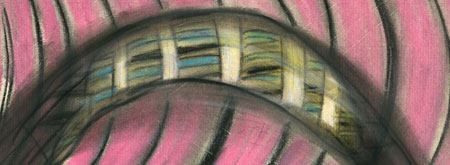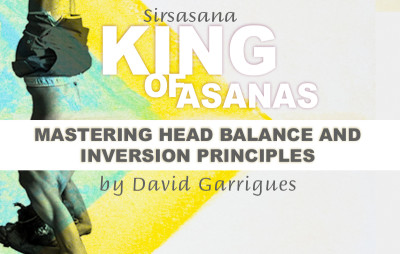In the past I have had many students express fear, sometimes dread, towards inversions, especially Sirsasana the most challenging upside-down posture. So it may seem like an unlikely choice that I use Head Balance as a foundational posture, as well as a gateway through which something magical and potent can happen in your yoga practice. Studying and practicing The King of Asanas master series will take you on a journey—a journey where you acquire a many skills and strength needed to properly learn and execute Sirsasana. And, what is truly amazing, this work not only offers instruction and demonstration on proper Head Balance—it helps us to uncover the essential asana principles upon which all yoga postures are based.
King of Asanas includes 7 challenging and fun instructional videos, each 15 to 30 minutes in length. The practices and teachings in the videos represent what I see as the most critical elements to extracting the essence of inversion positions in general, and specifically, the King of Asanas, Sirsasana, the Head Balance posture.
Working with this material, in the videos and the book, will improve, possibly even transform, your entire approach to yoga practice. I have taught this material to students for over two decades. I consider these instructions to be essential for a daily yoga practice. My aim is for you to place more value on the inversion portion of your practice. In doing so, you will become more skilled at extracting the nectar of yoga knowledge from all your postures, whether you are upside down or right side up.
About the videos in King of Asanas: A Master Series on Head Balance and Inversion Principles.
DAY 1 introduces the basic postures and the overarching themes of this course. You will look at two of the most basic standing postures Samasthiti, (Equal Standing) and Vrkshasana (Tree Posture) to gain skills that will help you achieve Head Balance. I offer a working definition of inversion as: any posture where your abdomen is higher than your head. You will take a look at the benefits of understanding that even common postures, such as standing forward bends, are inversions and learn to extract their benefits. There are exercises that teach how you can come to an edge of imbalance in order to find a position of maximum enjoyment and stability. Day 1 also sets the template for daily strength work that will help you gain the necessary strength to come up and stay up in Sirsasana (Head Balance). This includes using Downward Dog and Forearm Balance variations as excellent preparatory postures to Head Balance. Lastly, you will make a detailed study of setting up a safe and effective arm foundation for Sirsasana and learn an excellent Head Balance preparation position.
Summary of Day 1 exercises:
1 - Samasthiti (Equal Standing Posture)
2 - Vrkshtasana (Tree Posture) plus variations
3 - Padangusthasana (Big Toe Posture) and Padahastasana (Hands Under Feet Posture) with wall
4 - Plank
5 - Adho Mukha Svanasana (Downward Facing Dog Posture)
6 - Pincha Mayurasana (Forearm Balance Posture) preparation
7 - Sirsasana (Head Balance Posture) foundation focus on upper back
DAY 2 begins with utilizing the basic standing positions Samasthiti (Equal Standing), Vrshasana and Ardha Baddha Padmottanasana (Half Bound Lotus Standing Forward Bend) to solve postural puzzles that requires your skill in balance, preparing you for the greater challenge of balancing in Sirsasasna. You’ll do targeted arm and upper-body work in order to safely and incrementally develop balance and strength for Sirsasana. Part of the focus of this session is to create a feeling for the accurate arrangement of the whole line of your joints along the vertical axis—from the pelvic floor through the crown of the head. Finding this line becomes extra challenging when you are upside down, and you learn how to work intelligently to solve common problems. You’ll develop safe and supportive foundation for your Sirsasana and work to craft a set of Head Stand preparatory exercises that are not only fun and challenging, but build the skills you need to effectively come up into a vertical, upside down position. Lastly you’ll learn the thrilling and important crouch and spring exercise that teaches you the beginning stages of coming up into Sirsasasna.
Summary of Day 2 exercises:
1 - Samasthiti
2 - Vrkshtasana plus variations
3 - Ardha Baddha Padmottanasana (Half Bound Lotus Standing Forward Bend Posture)
4 - Plank
5 - Adho Mukha Svanasana plus variations
6 - Sirsasana foundation
7 - Sirsasana foundation focus on upper back
8 - Crouch and Spring entrance into Sirsasana using wall
9 - Crouch and Spring entrance into Sirsasana without wall
DAY 3 you are introduced to the imagery of the Nine Spotlights for aligning your body accurately along the vertical axis in Samasthiti and Sirsasana You’ll learn to see Prasarita Padottanasana (Wide Angle Forward Bend) not only as a forward bend but also as a preparation for Sirsasana. You’ll take an in-depth look at how doing preparatory exercises for Pincha Mayurasana (Forearm Balance) serves as a safe, fun and challenging means of skill building for Head Balance. You’ll learn that as a beginner in Sirsasana, the proper distribution weight is having at least 50% of your weight should be borne by your arms. Lastly, you’ll work at wall and gain the skill to create a dynamic crouch and spring entrance into Sirsasana.
Summary of Day 3 exercises:
1 - Samasthtii
2 - Prasarita Padottanasana
3 - Pincha Mayurasana set up
4 - Sirsasana set up
5 - Crouch and Spring entrance to Sirsasana with wall
DAY 4 begins looking how to use dynamism to create a powerful stance in Samasthiti, and variations are added. You’ll do Vrshasana using a wall, which helps you generate skill in balance by illuminating the central axis from the crown of the head to the arches of the feet. You’ll also work on a standing forward bend exercises at the wall, which offers a thrill in finding the balance and stability when you vertically align your hips, knees and ankles. You’ll do in depth work on Head Balance preparatory exercises that emphasize strength building, and learn to enjoy in remaining upside down. Lastly, you’ll work progressively in ordered steps that lead you to skillfully, and with control, go up and come down in Sirsasana. Up to this point, you have worked with at the wall, and now you’ll have the opportunity to try Sirsasana away from the wall.
Summary of Day 4 exercises:
1 - Samasthiti
2 - Vrksasana with wall
3 - Padangusthasana and Padahastasana with wall
4 - Sirsasana set up and variations
5 - Crouch and Spring to Sirsasana entrance and variations
DAY 5 you will learn a wall variation of Prasarita Padottanasana, the inverted wide-legged standing forward bend. By grounding your legs into a wall you can find an immovable position and tune in to the meditative rest that inverted positions offer. Another main reason that inversions are such an important category of asanas is going upside down automatically gives you a feeling for engaging your bandhas, (energetic locks) especially the first, easiest bandha that is called uddhyana, which means ‘flying up’. You’ll experiment with a hollowing action of the abdomen in several different positions. Day 5 will give you the final step in the learning progression of going up and coming down in Sirsasana. It’s done with straight legs, without kicking up. You will attempt a seamless transition into your vertical position with one smooth gesture that is synchronized with an inhalation, and then you reverse the process by gesturing all the way down to your set up position with a controlled exhalation. First you learn to do it near a wall and eventually you gain the skill to do it without a wall. I also take you incrementally through steps that teach you how to fall out of Head Balance with control by doing a forward somersault.
Summary of Day 5 exercises:
1 - Samasthiti
2 - Prasarita Padottanasana with wall
3 - Uddiyana (Flying Up) Bandha (Energetic Lock) Kriya (Cleansing)
4 - Adho Mukha Svanasana with focus on Uddiyana Bandha
5 - Sirsasana set up and variations with wall
6 - Sirsasana set up and variations
DAY 6 you will explore how passive inversions bring restorative and meditative possibilities to your practice. One of my goals for offering this course is to give you different glimpses into the versatility of inversions. I aim to show you that they offer many, many contrasting benefits from total rest and rejuvenation, to dynamism and hard-won strength, to clear inward absorption. While staying for longer periods of time in these passive positions, you’ll work with foundational pranayama breathing techniques. You’ll also learn an easy way to do Head Balance without putting any weight on your head. This weightless version of Sirsasana can come in handy when you are injured or tired.
Summary of Day 6 exercises:
1 - Samasthiti
2 - Viparita Karani (Legs Up the Wall Posture)
3 - Sirsasana with blocks under shoulders
DAY 7 will review the list of postures that support Sirsasana, which include asanas of strengthening, gaining balance, activating bandhas, and bring meditative awareness. You will work with preparation in Bhujapidasana (Arm Pressure Posture), and also Bakasana (Crane Posture), to build upper body strength, and improve your balance. You’ll contemplate the inherent contradictory and paradoxical nature of Sirsasana—how, on the one hand it is a position of danger, dynamism, and risk, and on the other hand, it is a posture of stillness, quiet, sanctuary, peace and receptivity. You’ll learn an intense and fun, super dynamic exercise for working on the transition of going up and coming down in Sirsasana. You’ll work on the technique of taking Padmasana (Full Lotus Posture) while inverted. Finally, you’ll go up in Headstand and stay up for some time (1 minute), receiving instructions for how to maintain a safe, aligned position that comes from awakening prana, the energetic circuitry throughout the body.
Summary of Day 7 exercises:
1 - Samasthiti
2 - Bhujapidasana (Arm Pressure Posture)
3 - Bakasana (Crane Posture)
4 - Sirsasana entrance
5 - Sirsasana variations
6 - Sirsasana complete version
Download and Streaming Information
1) Once you purchase the course you will receive a message from VHX with a link to your videos. The email will be sent to the email address you input at checkout so make sure you choose an email you frequently use. If you don't see the email in your inbox please make sure to check your spam folder.
2) You can stream or download the course.
3) To download a video, click on the bottom left hand corner of each individual video and you'll see a download button. Unfortunately, you can only download one video at a time.



Comments
No comments.